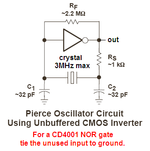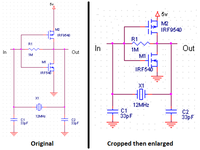joeypc
Newbie

Hello Everybody,
I built a discrete CMOS inverter as shown below:

This CMOS inverter worked as an logic inverter very well. But when I tried to apply to crystal oscillator as below. It did not work at all! Could anyone here explain why ? Thanks all.

I built a discrete CMOS inverter as shown below:
This CMOS inverter worked as an logic inverter very well. But when I tried to apply to crystal oscillator as below. It did not work at all! Could anyone here explain why ? Thanks all.




